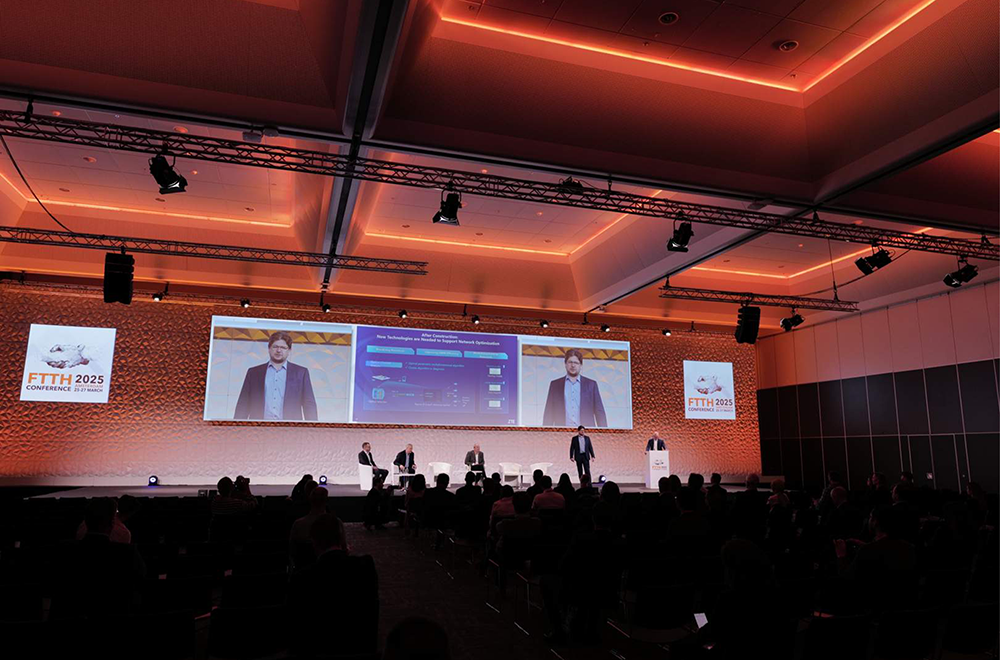Data
Data
Data Centres
News
Scalable Network Attached Solutions for Modern Infrastructure
Innodisk launches SSD series for data centre applications
Innodisk, an industrial-grade flash storage provider, has announced the launch of its latest PCIe Gen5 SSD series, which is designed to meet the OCP Data Centre NVMe SSD spec v2.0 and the increasing demands of AI model training, big data analytics, and data-intensive environments.
The new series supports multiple form factors, including U.2, as well as EDSFF E1.S, E3.S, and the brand new E3.L for data centre applications, catering to the diverse needs of enterprise and data centre environments. Innodisk tells us that the new series marks a new chapter for the company in terms of further fulfilling enterprise demands.
The Innodisk PCIe Gen5 SSD, built with the latest PCIe Gen 5 x4 interface and NVMe 2.0 protocol, is designed to overcome the speed and latency limitations of traditional storage interfaces. With up to 128TB of high density NAND storage, it delivers speeds of up to 14GB/s (read) and 10GB/s (write), enabling lightning-fast data transfers for data-intensive applications.
Enterprise data centres managing large-scale storage deployments and multi-tiered environments often require out-of-band and batch management capabilities, which present growing challenges. Innodisk PCIe Gen5 SSD addresses these demands with NVMe-MI for streamlined SSD management and multi namespace support, ensuring scalable and efficient storage operations.
To ensure high quality and alignment with market trends, the PCIe Gen5 SSD aims to enhance integration with industry-leading data centre standards, such as OCP Data Centre NVMe SSD spec v2.0. Additionally, it is intended to be built for seamless integration with VMware, optimising compatibility with virtualisedenvironments and overall system performance.
Innodisk’s PCIe Gen5 SSD also features advanced security mechanisms, ensuring robust data protection and seamless integration. Secure Boot technology authenticates digital signatures during firmware updates, preventing unauthorised modifications and ensuring that only trusted firmware is executed.
Simon Rowley - 29 April 2025
Data
News
Lenovo data storage portfolio set to accelerate IT modernisation
Lenovo has announced its largest storage portfolio refresh in company history, unveiling new Lenovo Data Storage Solutions that prepare enterprise IT for the age of AI with better efficiency, performance and scalability.
Ushering in a new era of AI-optimised storage that propels business transformation, the complete portfolio includes storage arrays, software defined storage (SDI), and new AI and virtualisation innovations to flexibly address rapidly evolving data operations. Using the solutions, businesses can easily run AI and data modernisation workloads on the next generation of trusted Lenovo ThinkSystem and ThinkAgile infrastructure, unleashing data to power real-time reasoning and confidently deploying AI and data modernisation workloads at scale.
As business leaders seek tangible ROI on AI investment, EMEA IDC research commissioned by Lenovo found that data sovereignty, compliance and quality data are the most important AI implementation success factors among CIOs while scaling AI and data quality are among the biggest obstacles. The new portfolio reflects Lenovo’s ongoing commitment to delivering innovative storage solutions that meet the evolving needs of modern data centres while helping businesses get the most out of their data.
“The new Lenovo Data Storage Solutions help businesses harness AI’s transformative power with a data-driven strategy that ensures scalability, interoperability, and tangible business outcomes powered by trusted infrastructure,” says Scott Tease, Vice President and General Manager of Infrastructure Solutions Product Group at Lenovo. “The new solutions help customers achieve faster time to value no matter where they are on their IT modernisation journey with turnkey AI solutions that mitigate risk and simplify deployment.”
Marco Pozzoni, Director, EMEA Storage Sales at Lenovo Infrastructure Solutions Group, remarks, “This is a pivotal moment for our customers across EMEA. With organisations facing a range of complex challenges, our largest-ever data storage portfolio refresh delivers the performance, efficiency, and data resiliency required by data modernisation and enterprise AI workloads. At a time when businesses are increasingly looking for ROI on their tech investments, these next-generation data storage solutions will empower our customers to unleash the power of their data, securely.”
The portfolio spans 21 new ThinkSystem and ThinkAgile models designed with the accelerated computing and efficiency that companies need to kickstart their AI journey, supporting employee productivity and maximising value with solutions for enterprise AI, virtualisation and sustainability. Key innovations include turnkey AI Starter Kits, the industry’s first liquid cooled HCI appliances and converged hybrid cloud and virtualisation solutions. The Data Storage Solutions are finetuned for easy deployment, faster inferencing, workload consolidation and lower total cost of ownership (TCO), delivering enhanced capabilities.
• Lenovo ThinkAgile SDI V4 Series provides full-stack, turnkey solutions that simplify IT infrastructure and accelerate computing for data-driven reasoning and faster time to value for AI LLM inferencing workloads.• Engineered to put actionable data insights to work more quickly in business operations, the new Lenovo ThinkSystem Storage Arrays deliver up to three times faster performance while reducing power consumption, providing up to 97% energy savings and 99% density improvement over a Lenovo device featuring 10K HDDs for smaller data centre footprints and lower TCO and when upgrading legacy infrastructure.• New converged Lenovo ThinkAgile and ThinkSystem hybrid cloud and virtualisation solutions deliver flexible and efficient independent scaling of compute and storage capabilities, reducing software licensing costs up to 40%, maximising business value.• New Lenovo ThinkAgile HX Series GPT-in-a-Box solutions featuring Lenovo Neptune Liquid Cooling leverage the industry’s first liquid cooled HCI appliance to deliver turnkey AI inferencing that takes AI from concept to success across distributed applications, from edge to cloud, yielding up to 25% energy savings over previous generation to increase ROI and achieve data-driven breakthroughs.• New AI Starter Kits for Lenovo Hybrid AI Platform deliver a validated, flexible, and easy on-ramp for enterprise inferencing and retrieval-augmented (RAG) workflows.
For more from Lenovo, click here.
Simon Rowley - 24 April 2025
Artificial Intelligence in Data Centre Operations
Data
Data Centre Operations: Optimising Infrastructure for Performance and Reliability
News
Fluidstack selects VAST Data to power AI workloads
VAST Data, an AI data platform company, today announced that Fluidstack, the AI cloud platform, has selected the VAST Data Platform to join other partners in helping to power large-scale, high-performance AI workloads for Fluidstack’s global customer base. With VAST, Fluidstack can deliver enterprise-grade stability, security, and innovation for some of the most demanding AI training environments in the world.
Fluidstack has built its business by managing end-customer workloads on third-party compute capacity – from VAST-powered AI cloud service provider customers to building dedicated GPU clusters on behalf of clients. Pushing the boundaries of what managed services can offer, Fluidstack uses a flexible problem-solving approach to help end customers manage and scale their workloads with unmatched reliability and agility.
Our mission at Fluidstack is to take the complexity out of deploying and scaling AI infrastructure for our customers,” says César Maklary, President & Co-Founder of Fluidstack. “VAST’s platform gives us the advanced enterprise capabilities we need to deliver reliable, scalable, secure, and future-proof AI infrastructure for our customers as they build cutting-edge models to further AI adoption.
The VAST Data Platform provides Fluidstack’s end customers with:
• Reliable, secure data management: VAST’s enterprise-grade stability, multi-tenant security, and reliability were critical in supporting the demanding AI workloads that Fluidstack manages for customers, while the VAST DataStore’s multi-protocol support (S3, NFS, SMB) offered seamless interoperability for diverse application needs.• Future-proof AI infrastructure: To further support Fluidstack in building, operating, and managing AI infrastructure and workloads for customers, the VAST DataEngine provides integrated vector search capabilities, automated triggers, and intelligent data processing functions designed for large-scale model training and inference. Combined with the real-time data awareness and scalable semantic indexing of the VAST InsightEngine, Fluidstack is well-positioned to deliver increasingly intelligent, responsive, and globally efficient AI infrastructure services.• Fast access to distributed data at limitless scale: The VAST Data Platform’s unique Disaggregated Shared-Everything (DASE) architecture ensures these deployments can reach exabyte scale while remaining cost-efficient—helping Fluidstack empower organisations to use distributed datasets and enable globally-synchronised model training.• Bringing structure to unstructured data: The VAST DataBase serves as a transactional data lakehouse that supports trillions of vectors, allowing Fluidstack customers to index the entirety of their distributed data corpus for AI deployments - providing real-time data access for efficient querying, analysis, and retrieval of massive datasets.
Fluidstack’s innovative approach to AI infrastructure delivery requires a data platform that can operate globally, securely, and with the performance to match cutting-edge AI workloads,” says Renen Hallak, Founder & CEO of VAST Data. “Together with Fluidstack, we’re helping customers turn visionary projects into reality. The combination of Fluidstack’s dynamic managed services with VAST’s global data fabric and advanced enterprise features is unlocking new possibilities for AI model training and development at scale.
For more from VAST Data, click here.
Simon Rowley - 17 April 2025
Data
Data Centre Security: Protecting Infrastructure from Physical and Cyber Threats
News
Infosecurity Europe launches new cyber security masterclasses
Infosecurity Europe has announced the launch of ‘Infosecurity Europe Masterclasses, powered by SANS Institute’, an exclusive new training initiative designed to equip cybersecurity professionals with hands-on, practical skills.
Developed for Infosecurity Europe 2025, the Masterclasses will offer three deep-dive sessions covering Digital Forensics, Cloud Security and Security Culture. Each masterclass will be delivered by a SANS-certified instructor and will take place in the South Gallery Rooms at ExCeL London during the event. The Digital Forensics and Cloud Security Masterclasses will be held on Tuesday 3 June, with the Security Culture Masterclass on Wednesday 4 June.
Introducing these masterclasses highlights the growing demand for specialised training as organisations contend with an increasingly complex threat landscape. Infosecurity Europe has long been a hub for industry leaders to share knowledge, explore innovative solutions, and foster collaboration. The partnership with SANS Institute builds on this and enhances the event's educational offering.
"Partnering with Infosecurity Europe and bringing hands-on masterclasses to this year’s event is a pivotal moment to elevate security readiness across the UK and Europe,” says John Davis, UK Director, SANS Institute.
“This collaboration will support cyber security professionals with the practical skills they need to stay ahead of emerging threats. Continuous learning is essential in an industry that evolves at such a rapid pace, and by providing hands-on, immersive experiences, we are ensuring that security practitioners can apply cutting-edge techniques in real-world scenarios to make an immediate impact within their organisations,"
The masterclasses are designed to deliver practical, actionable insights and are tailored to help cyber security professionals tackle modern challenges head-on.
The Digital Forensics Masterclass will be led by SANS Certified Instructor Kathryn Hedley and will provide practical experience in decoding file signatures, data recovery techniques and forensic disk image exploration. Attendees will learn how to extract and interpret critical digital evidence across platforms, equipping them with the skills to handle complex forensic investigations. This session aligns closely with industry demand, as over 50% of organisations plan to increase investment in incident response and forensics according to Infosecurity Europe’s 2025 Cybersecurity Trends Report.
With 65% of cyber security leaders also planning an increase in cloud security investment, the Cloud Security Masterclass is key to guiding participants through advanced cloud security practices. Hosted by SANS Certified Instructor Simon Vernon, topics will include securing logging setups in Azure and preventing remote code execution.
On day two, the Security Culture Masterclass will be fronted by SANS Certified Instructor John Scott and will directly address key challenges faced by organisations. Infosecurity Europe’s report shows respondents citing lack of accountability and identifying communication gaps between departments as major obstacles to building a strong cyber security culture. This interactive session will address these challenges and more with a focus on embedding a resilient security culture within organisations.
Participants will engage in the Cyber42 Game Day simulation, where they will navigate real-world decision-making scenarios to strengthen their leadership and cultural impact.
Carly Weller - 14 April 2025
Cyber Security Insights for Resilient Digital Defence
Data
Data Centre Security: Protecting Infrastructure from Physical and Cyber Threats
Enterprise Network Infrastructure: Design, Performance & Security
News
Cyber attacks drop by nearly 10%
Four in 10 (43%) of UK businesses and 30% of charities experienced cyber attacks or data breaches in the last 12 months, according to the latest Cyber Security Breaches Survey. While this marks a slight decrease from last year’s 50%, the threat level for medium and large businesses remains alarmingly high.
The average cost of the most disruptive breach was estimated at £1,600 for businesses and £3,240 for charities.
The drop in incidents is attributed mainly to fewer small businesses reporting breaches – but government officials warn against complacency. With cyber threats increasingly targeting critical infrastructure, the UK Government is introducing the Cyber Security and Resilience Bill, compelling organisations to strengthen their digital defences.
The survey found that 70% of large businesses now have a formal cyber strategy in place, compared to just 57% of medium-sized firms – exposing a potential gap in preparedness among mid-sized enterprises.
There has been a notable improvement in cyber hygiene practices among smaller businesses, with rising adoption of risk assessments, cyber insurance, formal cyber security policies and continuity planning.
These steps are seen as essential in building digital resilience across the UK economy.
However, the number of high-income charities implementing best practices such as risk assessments has declined. Insights suggest this may be linked to budgetary pressures, limiting their ability to invest in adequate cyber security measures.
Sawan Joshi, Group Director of Information Security at FDM Group, comments, “Keeping banking systems online is becoming more challenging, and technology alone isn’t enough. Skilled IT teams are crucial for spotting risks early and responding quickly to prevent disruptions. Organisations need to invest in ongoing training so their staff can strengthen system defences and recover fast when issues arise. A mix of advanced monitoring, backup systems, and a well-trained workforce is key to keeping services running and maintaining customer trust.'"
The Government has also confirmed that UK data centres are now officially designated as critical national infrastructure. This means they will receive the same priority in the event of a major incident - such as a cyber attack - as essential services like water and energy.
Carly Weller - 11 April 2025
Artificial Intelligence in Data Centre Operations
Data
Data Centre Operations: Optimising Infrastructure for Performance and Reliability
Enterprise Network Infrastructure: Design, Performance & Security
News in Cloud Computing & Data Storage
Juniper and Google Cloud enhance branch deployments
Juniper Networks has announced its collaboration with Google Cloud to accelerate new enterprise campus and branch deployments and optimise user experiences. With just a few clicks in the Google Cloud Marketplace, customers can subscribe to Google’s Cloud WAN solution alongside Juniper Mist wired, wireless, NAC, firewalls and secure SD-WAN solutions.
Unveiled at Google Cloud Next 25, the solution is designed to simply, securely and reliably connect users to critical applications and AI workloads whether on the internet, across clouds or within data centres.
“At Google Cloud, we’re committed to providing our customers with the most advanced and innovative networking solutions. Our expanded collaboration with Juniper Networks and the integration of its AI-native networking capabilities with Google’s Cloud WAN represent a significant step forward,” says Muninder Singh Sambi, VP/GM, Networking, Google Cloud. “By combining the power of Google Cloud’s global infrastructure with Juniper’s expertise in AI for networking, we’re empowering enterprises to build more agile, secure and automated networks that can meet the demands of today’s dynamic business environment.”
AIOps key to GenAI application growth
As the cloud expands and GenAI applications grow, reliable connectivity, enhanced application performance and low latency are paramount. Businesses are turning to cloud-based network services to meet these demands. However, many face challenges with operational complexity, high costs, security gaps and inconsistent application performance. Assuring the best user experience through AI-native operations (AIOps) is essential to overcoming these challenges and maximising efficiency.
Powered by Juniper’s Mist AI-Native Networking platform, Google’s Cloud WAN, a new solution from Google Cloud, delivers a fully managed, reliable and secure enterprise backbone for branch transformation. Mist is purpose-built to leverage AIOps for optimised campus and branch experiences, assuring that connections are reliable, measurable and secure for every device, user, application and asset.
“Mist has become synonymous with AI and cloud-native operations that optimise user experiences while minimising operator costs,” says Sujai Hajela, EVP, Campus and Branch, Juniper Networks. “Juniper’s AI-Native Networking Platform is a perfect complement to Google’s Cloud WAN solution, enabling enterprises to overcome campus and branch management complexity and optimise application performance through low latency connectivity, self-driving automation and proactive insights.”
Google’s Cloud WAN delivers high-performance connections for campus and branch
The campus and branch services on Google’s Cloud WAN driven by Mist provide a single, secure and high-performance connection point for all branch traffic. A variety of wired, wireless, NAC and WAN services can be hosted on Google Cloud Platform, enabling businesses to eliminate on-premises hardware, dramatically simplifying branch operations and reducing operational costs. By natively integrating Juniper and other strategic partners with Google Cloud, Google’s Cloud WAN solution enhances agility, enabling rapid deployment of new branches and services, while improving security through consistent policies and cloud-delivered threat protection.
Carly Weller - 11 April 2025
Artificial Intelligence in Data Centre Operations
Cooling
Data
Data Centre Operations: Optimising Infrastructure for Performance and Reliability
Data Centres
Liquid Cooling Technologies Driving Data Centre Efficiency
Compu Dynamics launches AI and HPC Services unit
Compu Dynamics has announced the launch of its full lifecycle AI and High-Performance Computing (HPC) Services unit, showcasing the company’s end to end capabilities.
The expanded portfolio encompasses the entire spectrum of data centre needs, from initial design and procurement to construction, operation and ongoing maintenance, with a particular emphasis on cutting-edge liquid cooling technologies for AI and HPC environments.
Compu Dynamics’ new AI and HPC service offerings build on the company’s expertise in white space deployment, including advanced liquid cooling and post-installation services. As a vendor-neutral solutions provider, the company is uniquely positioned to support equipment from virtually every manufacturer with no geographical limitations, ensuring clients receive unbiased recommendations and optimal solutions tailored to their specific requirements.
"Our advanced AI and HPC service offerings represent a significant evolution in data centre services," says Steve Altizer, President and CEO of Compu Dynamics. “We have created this team to respond to the accelerating demand for highly-qualified technical support for high-density AI data centre infrastructure. By working with a variety of OEM partners and offering true end-to-end solutions, we are empowering our clients to focus on their core business while we handle the complexities of their modern critical infrastructure."
The company’s holistic solutions portfolio addresses the growing need for specialised support in high-density computing environments. Compu Dynamics’ innovative liquid cooling solutions are said to offer superior efficiency and reduced energy consumption, making them essential for future-ready data centres. Key highlights of these service offerings include:
· Equipment evaluation, design consultation and procurement.
· Power distribution and liquid cooling system installation, startup, commissioning and quality assurance/quality control.
· Flexible maintenance service options designed for seamless, worry-free support including comprehensive fluid management, coolant sampling and contamination and corrosion prevention.
· Onsite staffing for day-to-day technical operations.
· Dedicated customer success manager.
· 24x7 emergency response team for technical issues and repair services.
"As AI and HPC workloads drive unprecedented demand on data centre infrastructure, our liquid cooling expertise has become increasingly crucial,” says Scott Hegquist, Director of AI/HPC Services at Compu Dynamics. “We're committed to helping our clients navigate these challenges, providing cutting-edge solutions that optimise performance, efficiency and sustainability."
Carly Weller - 11 April 2025
Data
Data Centres
New PCIe 5.0-compatible broadband optical SSD
KIOXIA Corporation, AIO Core Co. and Kyocera Corporation have announced the development of a prototype PCIe 5.0-compatible broadband SSD with an optical interface (broadband optical SSD). The three companies will develop technologies for broadband optical SSDs to enhance their suitability for advanced applications that require high-speed transfer of large data, such as generative AI, and will also apply them to proof-of-concept (PoC) tests for future social implementation.
The new prototype achieved functional operation with the high-speed PCIe 5.0 interface, which is twice the bandwidth of the previous PCIe 4.0 generation, through the combination of AIO Core’s IOCore optical transceiver and Kyocera’s OPTINITY optoelectronic integration module technologies.
In next-generation green data centres, replacing the electrical wiring interface with optical and utilising broadband optical SSD technology can significantly increase the physical distance between the compute and storage devices, while maintaining energy efficiency and high signal quality. It also contributes to the flexibility and efficiency of data centre system design, where digital diversification and the evolution of generative AI require complex, high-volume and high-speed data processing.
This achievement is the result of the Japanese ‘Next Generation Green Data Center Technology Development’ project JPNP21029. It is subsidised by the New Energy and Industrial Technology Development Organization (NEDO), which is under the ‘Green Innovation Fund Project: Construction of Next Generation Digital Infrastructure’.
In this project, companies will develop next-generation technologies with the goal of achieving more than 40% energy savings compared to current data centres. As part of this project, KIOXIA is developing broadband optical SSDs, AIO Core is developing optoelectronic fusion devices and Kyocera is developing optoelectronic device packages.
Axel Stoermann, Chief Technology Officer and Vice President at KIOXIA Europe, comments, “As we enter a new era where AI and high-performance data centres form the foundation of societal advancement, it's essential to address the challenge of power management to ensure our strides in technology align with global sustainability goals.
"This new prototype of a PCIe 5.0-compatible broadband SSD with an optical interface has the real potential to revolutionise data centres and to make them truly sustainable.”
Carly Weller - 10 April 2025
Data
Enterprise Network Infrastructure: Design, Performance & Security
ZTE enhances all-optical networks with smart ODN solutions
Hans Neff, Senior Director of ZTE CTO Group, recently delivered a keynote speech entitled ‘Embracing the AI Era to Accelerate the Development of All-Optical Networks’ at the FTTH Conference 2025 in Amsterdam, sharing the company's solutions and experience in focusing on AI empowerment to achieve intelligent ODN, improve the deployment efficiency of all-optical networks, and reduce deployment and O&M costs.
At present, the deployment of all-optical networks is continuously accelerated, and the rapidly developing AI is increasingly integrated into broadband IT systems, significantly improving the intelligent level of FTTx deployment, operation and maintenance. In Europe, the National Broadband Plan (NBP) and the EU policies are actively advocating for an all-optical, gigabit and digitally intelligent society, and the demand for sustainable, efficient and future-oriented network infrastructure is growing.
Hans pointed out that operators are facing challenges such as high costs, complex network management and diverse deployment scenarios. AI and digital intelligence can provide end-to-end support for ODN construction in multiple aspects. Hans described how ZTE leverages AI technology to build intelligent ODNs across the entire process, enhancing efficiency and reducing operational complexity.
He elaborated on the specific applications and advantages of intelligent ODN across three phases: before, during and after deployment. Before deployment, one-click zero-touch site surveys, AI-based automatic planning and design, and paperless processes replace traditional manual methods, significantly reducing the time and human resources required. During deployment, real-time visualised and cost-effective solutions, along with tailored product combinations - such as pre-connectorised splice-free ODN, plug-and-play deployment and air-blowing solutions - ensure smooth construction while reducing both time and labour costs.
After deployment and delivery, intelligent real-time ODN network detection, analysis and risk warnings minimise fault location time, improving monitoring accuracy and troubleshooting efficiency. Additionally, new solutions like passive ID branch detection enable 24/7 real-time optical link monitoring, dynamic perception of link changes and automatic updates, ensuring 100% accuracy of end-to-end ODN resources. This proactive approach optimises network performance while streamlining maintenance and resource management.
Hans emphasised that collaboration among multiple parties is key to accelerating the construction of intelligent ODN networks. Suppliers play a vital role in driving digital and intelligent platforms, developing innovative product portfolios and delivering localised solutions through strategic partnerships. By leveraging AI and digital intelligence, operators and stakeholders can effectively address challenges such as high costs, complex construction and maintenance, and regional adaptability.
ZTE says it is committed to providing comprehensive intelligent ODN solutions and building end-to-end all-optical networks. Moving forward, ZTE will continue collaborating with global partners to harness its advanced network and intelligent capabilities. ZTE aims to help operators build and operate cutting-edge, efficient and intelligent broadband networks, unlocking new application scenarios and fostering a ubiquitous, green and efficient era of all-optical networks.
Carly Weller - 9 April 2025
Cyber Security Insights for Resilient Digital Defence
Data
Data Centres
News
Industry experts react to World Backup Day
Today, 31 March, marks this year's World Backup Day, and industry experts say that it once again offers a timely reminder of how vulnerable enterprise data can be.
Fred Lherault, Field CTO at Pure Storage, says that businesses cannot afford to think about backup just one day, every year, and predicts that 2025 could be a record-setting year for ransomware attacks.
Commenting on the day, Fred says, “31 March marks World Backup Day, serving as an important reminder for businesses to reassess their data protection strategies in the wake of an ever-evolving, and ever-growing threat landscape. However, cyber attackers aren’t in need of a reminder, and are probing for vulnerabilities 24/7 in order to invade systems. Given the valuable and sensitive nature of data, whether it resides in the public sector, healthcare, financial services or any other industry, businesses can’t afford to think about backup just one day per year.
“Malware is a leading cause of data loss, and ransomware, which locks down data with encryption rendering it useless, is among the most common forms of malware. In 2024, there were 5,414 reported global ransomware attacks, an 11% increase from 2023. Due to the sensitive nature of these kinds of breaches, it’s safe to assume that the real number is much higher. It’s therefore fair to suggest that 2025 could be a record setting year for ransomware attacks. In light of these alarming figures, there is no place for a ‘it won’t happen to me’ mindset. Businesses need to be proactive, not reactive in their plans - not only for their own peace of mind, but also in the wake of new cyber resiliency regulations laid down by international governments.
“Unfortunately, while backup systems have provided an insurance policy against an attack in the past, hackers are now trying to breach these too. Once an attacker is inside an organisation’s systems, they will attempt to find credentials to immobilise backups. This will make it more difficult, time consuming and potentially expensive to restore.”
Meanwhile, Dr. Thomas King, the CTO of global internet exchange operator, DE-CIX, offers his own remarks about the occasion.
Thomas explains, “World Backup Day has traditionally carried a very simple yet powerful message for businesses: backup your data. A large part of this is 'data redundancy' – the idea that storing multiple copies of data in separate locations will offer greater resilience in the event of an outage or network security breach. Yet, as workloads have moved into the cloud, and AI and SaaS applications have become dominant vehicles for productivity, the concept of 'redundancy' has started to expand. Businesses not only need contingency plans for their data, but contingency plans for their connectivity. Relying on a single-lane, vendor-locked connectivity pathway is a bit like only backing your data up in one place – once that solution fails, it’s game over.
“In 2025, roughly 85% of software used by the average business is SaaS-based, with a typical organisation using 112 apps in their day-to-day operations. These cloud-based applications are wholly dependent on connectivity to function, and even minor slow-downs caused by congestion or packet loss on the network can kill productivity. This is even more true of AI-driven workloads, where businesses depend on low-latency, high-performance connectivity to generate real-time or near real-time calculations.
“Over the years, we have been programmed to believe that faster connectivity equals better connectivity, but the reality is far more nuanced. IT decision-makers frequently chase faster connections to improve their SaaS or AI performance, but 82% severely underestimate the impact of packet loss and the general performance of their connectivity. This is what some refer to as the 'Application Performance Trap' – expecting a single, lightning-fast connection to solve all performance issues. But what happens if that connectivity pathway becomes congested, or worse, fails entirely?
“This is why 'redundant' connectivity is essential. The main principle of redundancy in this context is that there should always be at least two paths leading to a destination – if one fails, the other can be used. This can be achieved by using a carrier-neutral Internet Exchange or IX, which facilitates direct peer-to-peer connectivity between businesses and their cloud-based workloads, essentially bypassing the public Internet. While IXs in the US were traditionally vendor-locked to a single carrier or data centre, neutral IXs allow businesses to establish multiple connections with different providers – sometimes to serve a particular use-case, but often in the interests of redundancy. Our research has shown that more than 80% of IXs in the US are now data centre and carrier neutral, presenting a perfect opportunity for businesses to not only back up their data, but also back up their connectivity this World Backup Day.”
To read more about World Backup Day, visit its official website by clicking here.
For more from Pure Storage, click here.
For more from DE-CIX, click here.
Simon Rowley - 31 March 2025

Head office & Accounts:
Suite 14, 6-8 Revenge Road, Lordswood
Kent ME5 8UD
T: +44 (0)1634 673163
F: +44 (0)1634 673173









